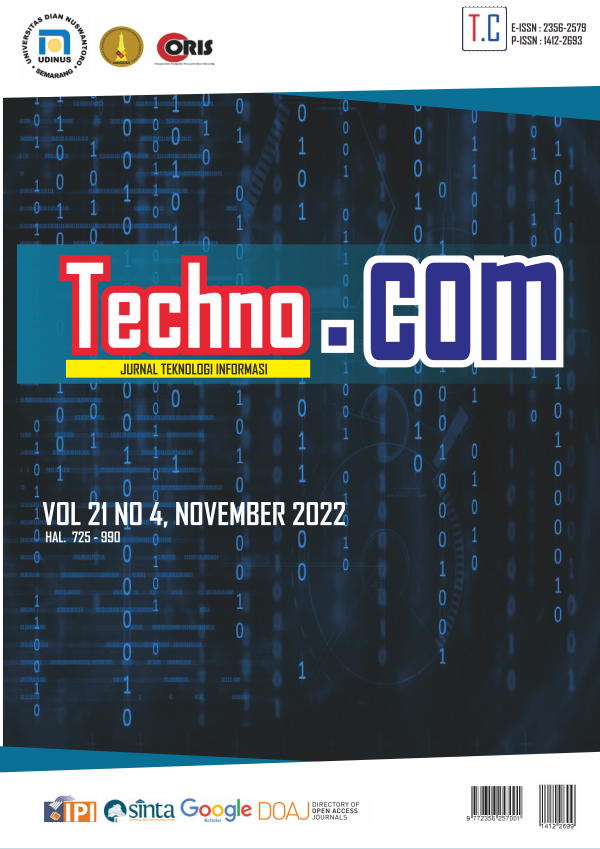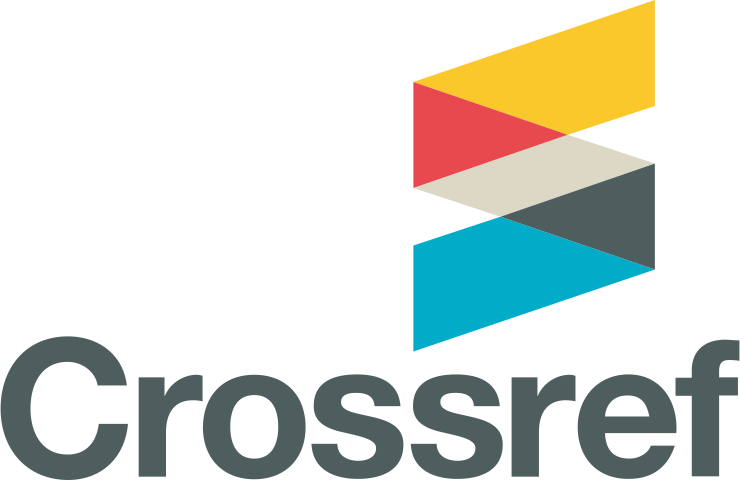Arsitektur U-Net pada Segmentasi Citra Hati sebagai Deteksi Dini Kanker Liver
DOI:
https://doi.org/10.33633/tc.v21i4.6669Keywords:
CNN, U-Net, Segmentation, LiverAbstract
Hati adalah salah satu organ tubuh manusia yang bertanggung jawab untuk mencerna, meyerap, dan memproses makanan serta berfungsi untuk menyaring darah dari saluran pencernaan sebelum dibawa kebagian organ tubuh lainnya. Hati sangat rentan terhadap berbagai penyakit, salah satunya yaitu kanker liver. untuk itu perlu dilakukannya deteksi sejak dini atau diagnosa terhadap organ hati. Untuk mengatasi permasalahan tersebut, pada penelitian ini dilakukan segmentasi hati menggunakan metode Convolutional Neural Network (CNN) dengan arsitektur U-Net pada citra hati. Langkah awal pada penelitian ini dilakukan pre-processing data yang menerapkan teknik green channel, histogram equalization (HE), dan contrast limited adaptive histogram equalization (CLAHE). Setelah itu dilakukan proses segmentasi sesuai dengan metode yang diusulkan. Penelitian ini menggunakan dataset hati yang didapatkan dari website Kaggle. Hasil penelitian menggunakan metode CNN arsitektur U-Net pada data mendapatkan nilai akurasi sebesar 97,62%, sensitivitas sebesar 89,84%, spesifisitas sebesar 98,37%, koefisen jaccard sebesar 76,99%, dan dice similarity coefficient (DSC) sebesar 87%. Berdasarkan hasil tersebut, dapat disimpulkan bahwa metode yang diusulkan memiliki hasil yang sangat baik dalam melakukan segmentasi terhadap citra hati.References
M. Rela, N. R. Suryakari, and P. R. Reddy, “Liver Tumor Segmentation and Classification: A Systematic Review,” Proc. 2020 IEEE-HYDCON Int. Conf. Eng. 4th Ind. Revolution, HYDCON 2020, pp. 21–26, 2020.
A. I. Falatehan, N. Hidayat, and K. C. Brata, “Sistem Pakar Diagnosis Penyakit Hati Menggunakan Metode Fuzzy Tsukamoto Berbasis Android,” J. Pengemb. Teknol. Inf. dan Ilmu Komput. Univ. Brawijaya, vol. 2, no. 8, pp. 2373–2381, 2018.
T. R. Latifatul Khairiah, Tursina, “Sistem Pakar Diagnosis Penyakit Hati Dengan Metode Dempster Shafer Berbasis Android,” J. Coding Sist. Komput. Untan, vol. 5, no. 2, pp. 57–66, 2017.
H. Sung et al., “Global Cancer Statistics 2020: GLOBOCAN Estimates of Incidence and Mortality Worldwide for 36 Cancers in 185 Countries,” CA. Cancer J. Clin., vol. 71, no. 3, pp. 209–249, 2021.
N. Alalwan, A. Abozeid, A. A. A. ElHabshy, and A. Alzahrani, “Efficient 3D Deep Learning Model for Medical Image Semantic Segmentation,” Alexandria Eng. J., vol. 60, no. 1, pp. 1231–1239, 2021.
A. Desiani, B. Suprihatin, S. Yahdin, A. I. Putri, and F. R. Husein, “Bi-path architecture of CNN segmentation and classification method for cervical cancer fisorders based on pap-smear images,” IAENG Int. J. Comput. Sci., vol. 48, no. 3, pp. 1–10, 2021.
A. A. Riadi, A. A. Chamid, and A. Sokhibi, “Analisis Komparasi Metode Perbaikan Kontras Berbasis Histogram Equalization Pada Citra Medis,” Simetris J. Tek. Mesin, Elektro dan Ilmu Komput., vol. 8, no. 1, pp. 383–388, 2017.
A. M. Anter and A. E. Hassenian, “CT liver tumor segmentation hybrid approach using neutrosophic sets, fast fuzzy c-means and adaptive watershed algorithm,” Artif. Intell. Med., vol. 97, no. September, pp. 105–117, 2019.
M. Rela, S. N. Rao, and P. R. Reddy, “Liver Tumor Segmentation using Superpixel based Fast Fuzzy C Means Clustering,” Int. J. Adv. Comput. Sci. Appl., vol. 11, no. 11, pp. 380–387, 2020.
L. Meng, Q. Zhang, and S. Bu, “Two?stage liver and tumor segmentation algorithm based on convolutional neural network,” Diagnostics, vol. 11, no. 10, 2021.
S. M. Anwar, S. Awan, S. Yousaf, and M. Majid, “Segmentation of liver tumor for computer aided diagnosis,” 2018 IEEE EMBS Conf. Biomed. Eng. Sci. IECBES 2018 - Proc., pp. 366–370, 2019.
J. Cai, “Segmentation and Diagnosis of Liver Carcinoma Based on Adaptive Scale-Kernel Fuzzy Clustering Model for CT Images,” J. Med. Syst., vol. 43, no. 11, 2019.
R. Zhang, Z. Zhou, W. Wu, C. C. Lin, P. H. Tsui, and S. Wu, “An improved fuzzy connectedness method for automatic three-dimensional liver vessel segmentation in CT images,” J. Healthc. Eng., vol. 2018, 2018.
M. Wang and W. Deng, “Deep visual domain adaptation: A survey,” Neurocomputing, vol. 312, no. April, pp. 135–153, 2018.
T. A. Soomro et al., “Deep learning models for retinal blood vessels segmentation: a review,” IEEE Access, vol. 7, pp. 71696–71717, 2019.
G. Du, X. Cao, J. Liang, X. Chen, and Y. Zhan, “Medical Image Segmentation based on U-Net: A Review,” J. Imaging Sci. Technol., vol. 64, no. 2, pp. 1–12, 2020.
T. Pranata, A. Desiani, B. Suprihatin, H. Hanum, and F. Efriliyanti, “Segmentation of the Lungs on X-Ray Thorax Image with CNN Architecture U-Net,” vol. 11, no. 2, pp. 101–111, 2022.
X. He, Z. Yu, T. Wang, B. Lei, and Y. Shi, “Dense deconvolution net: Multi path fusion and dense deconvolution for high resolution skin lesion segmentation,” Technol. Heal. Care, vol. 26, no. S1, pp. S307–S316, 2018.
N. Saeedizadeh, S. Minaee, R. Kafieh, S. Yazdani, and M. Sonka, “COVID TV-Unet: Segmenting COVID-19 chest CT images using connectivity imposed Unet,” Comput. Methods Programs Biomed. Updat., vol. 1, no. March, p. 100007, 2021.
L. Alzubaidi et al., Review of deep learning: concepts, CNN architectures, challenges, applications, future directions, vol. 8, no. 1. Springer International Publishing, 2021.
W. Chen, B. Yang, J. Li, and J. Wang, “An approach to detecting diabetic retinopathy based on integrated shallow convolutional neural networks,” IEEE Access, vol. 8, pp. 178552–178562, 2020.
M. M. Islam, T. N. Poly, B. A. Walther, H. C. Yang, and Y.-C. (Jack) Li, “Artificial intelligence in ophthalmology: a meta-analysis of deep learning models for retinal vessels segmentation,” J. Clin. Med., vol. 9, no. 4, p. 1018, 2020.
H. Ide and T. Kurita, “Improvement of learning for CNN with ReLU activation by sparse regularization,” Proc. Int. Jt. Conf. Neural Networks, vol. 2017-May, pp. 2684–2691, 2017.
J. Shi et al., “Improvement of damage segmentation based on pixel-level data balance using vgg-unet,” Appl. Sci., vol. 11, no. 2, pp. 1–17, 2021.
C. Wang, M. Gan, M. Zhang, and D. Li, “Adversarial convolutional network for esophageal tissue segmentation on OCT images,” Biomed. Opt. Express, vol. 11, no. 6, p. 3095, 2020.
R. A. Pangestu, B. Rahmat, and F. T. Anggraeny, “Implementasi Algoritma CNN untuk Klasifikasi Citra Lahan dan Perhitungan Luas,” Inform. dan Sist. Inf., vol. 1, no. 1, pp. 166–174, 2020.
L. Han, Y. Chen, J. Li, B. Zhong, Y. Lei, and M. Sun, “Liver segmentation with 2.5D perpendicular UNets,” Comput. Electr. Eng., vol. 91, no. January, p. 107118, 2021.
B. Kim and J. C. Ye, “Cycle-consistent adversarial network with polyphase U-Nets for liver lesion segmentation,” 1st Conf. Med. Imaging with Deep Learn., no. Midl, pp. 1–3, 2018.
J. Ma, Y. Deng, Z. Ma, K. Mao, and Y. Chen, “A Liver Segmentation Method Based on the Fusion of VNet and WGAN,” Comput. Math. Methods Med., vol. 2021, 2021.
X. Li, H. Chen, X. Qi, Q. Dou, C. W. Fu, and P. A. Heng, “H-DenseUNet: Hybrid Densely Connected UNet for Liver and Tumor Segmentation from CT Volumes,” IEEE Trans. Med. Imaging, vol. 37, no. 12, pp. 2663–2674, 2018.
Downloads
Published
Issue
Section
License
Copyright (c) 2022 Therezia Naraloka, Lucky Indra Kesuma, Ade Sukmawati, Marissa Cristianti

This work is licensed under a Creative Commons Attribution-NonCommercial 4.0 International License.
License Terms
All articles published in Techno.COM Journal are licensed under the Creative Commons Attribution-NonCommercial 4.0 International (CC BY-NC 4.0). This means:
1. Attribution
Readers and users are free to:
-
Share – Copy and redistribute the material in any medium or format.
-
Adapt – Remix, transform, and build upon the material.
As long as proper credit is given to the original work by citing the author(s) and the journal.
2. Non-Commercial Use
-
The material cannot be used for commercial purposes.
-
Commercial use includes selling the content, using it in commercial advertising, or integrating it into products/services for profit.
3. Rights of Authors
-
Authors retain copyright and grant Techno.COM Journal the right to publish the article.
-
Authors can distribute their work (e.g., in institutional repositories or personal websites) with proper acknowledgment of the journal.
4. No Additional Restrictions
-
The journal cannot apply legal terms or technological measures that restrict others from using the material in ways allowed by the license.
5. Disclaimer
-
The journal is not responsible for how the published content is used by third parties.
-
The opinions expressed in the articles are solely those of the authors.
For more details, visit the Creative Commons License Page:
? https://creativecommons.org/licenses/by-nc/4.0/
















